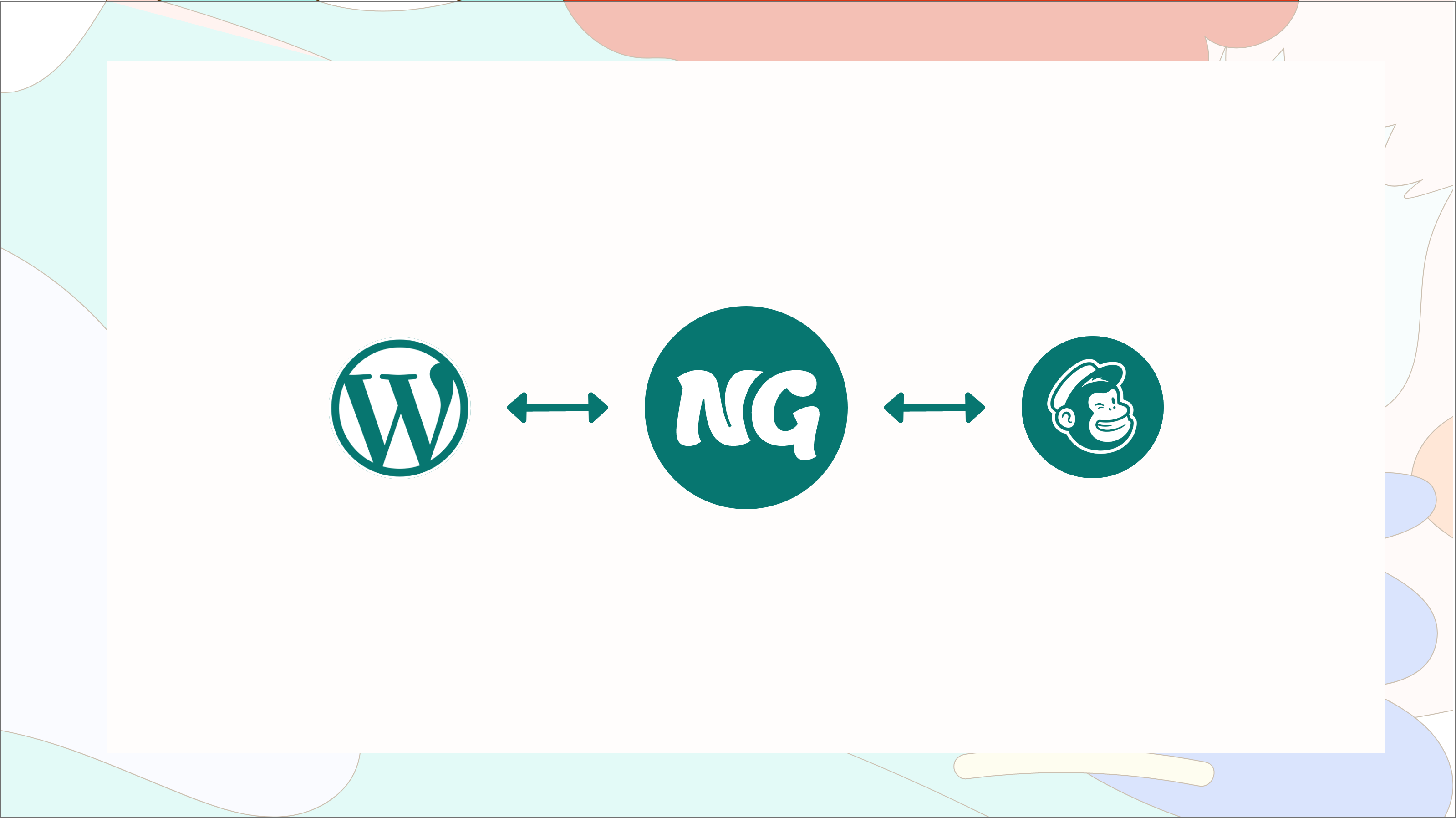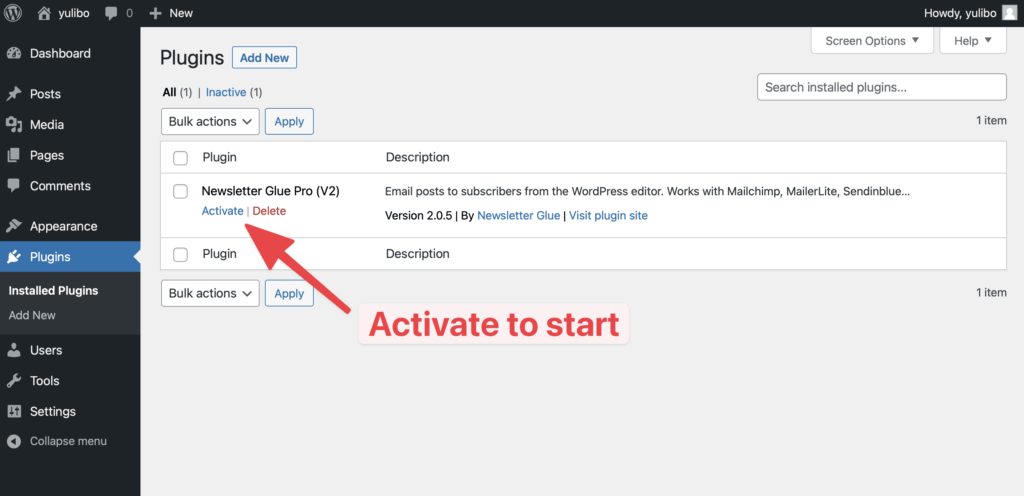This post is part 4 of 4 in the mega guide to setting up a paid newsletter with Memberful. Read part 1, 2, 3.
What is Newsletter Glue and why you should use it

Newsletter Glue is a WordPress plugin that transforms your WordPress editor (where you write blog posts) into a newsletter builder. Once you’ve written your newsletter in the WordPress editor, just hit Publish to send the newsletter out to your Mailchimp subscribers.
It saves you time by eliminating the need to write the same piece of content in both your email marketing software and WordPress. It also provides SEO benefits to your newsletters by making them rank on Google and other search engines.
How does it fit into our current workflow?
Let’s take a step back so that we can see what we’ve built so far and where Newsletter Glue fits in.
Right now, you have a Memberful account that connects to WordPress. This lets you sign people up to your paid newsletter and restrict content.
Memberful is also connected to Mailchimp. When someone purchases a subscription, Memberful tells Mailchimp to create a new subscriber.
However, you don’t have anything that connects Mailchimp and WordPress.
As things stand, you’d have to write your newsletters in Mailchimp, then head over to WordPress and reproduce the whole newsletter from scratch just so you have a SEO-friendly web version.
This is where Newsletter Glue comes in. With the plugin, you can skip that step entirely. Newsletter Glue transforms any post into a newsletter.
Just write your newsletter directly in WordPress and publish your post. Your post will be live on the website and sent to your subscribers, like magic!
Integrate your email service provider (ESP)
The first step to having your own newsletter builder on WordPress is connecting to your email service provider (ESP).
Newsletter Glue connects to multiple ESPs, including: Mailchimp, MailerLite, Campaign Monitor, ActiveCampaign, AWeber, and Sendinblue. For this guide, we’ll stick with Mailchimp. The instructions are the same for other services as well.
To connect the email service, let’s first install Newsletter Glue on our website.
Install and activate Newsletter glue
To demonstrate full capability of the plugin, we’ll use Newsletter Glue Pro for this tutorial.
First and foremost, head over to Newsletter Glue website and purchase the plugin.
Once you have the zip file of the plugin, go to your WordPress dashboard and navigate to Plugins > Add New.
Click on the Upload Plugin button at the top and choose the zip that you just downloaded to Install and Activate the plugin.

As soon as you do that, the onboarding wizard will start in your browser.
Onboarding wizard
The wizard will help you to set up the Newsletter Glue plugin on your website. The first step in the onboarding wizard is to validate your license key. You can find the key in your Newsletter Glue account or in the purchase confirmation email.
Copy and paste it into the box to verify your license and unlock Pro features from the plugin. Once done, click on Activate your copy and it will take you to the next step.

Set up email service provider (ESP)
In the second step, Newsletter Glue will display all of the email service providers with which it integrates.
Since we’ve been using Mailchimp for this guide, click on it and a box will appear down below for you to enter your API key. Copy and paste the API key from your Mailchimp account.

Click on the Connect button and it will validate the key and move you to the next step.
In the next step, you can select your Mailchimp audience list and segment that will receive your email newsletters. Below it, you can specify a From name and From email address to be used to send your newsletters. Your audience will see this as the sender in their inbox, so it’s best to use your brand name and a custom email address.

Once everything is done, click on the button at the bottom to move to the next step.
Personalize your newsletter pattern and add a logo
In this step, you need to provide your company or brand name and its physical address. This is important as it will be used in the footer of the newsletter and is also needed to comply with international anti-spam laws.

Once done, go to the next step to upload your logo and adjust its max-width. The logo you upload here will be used in the newsletter patterns.

Next, you can add your social media account links and click the button at the bottom to complete the onboarding wizard.

The plugin will automatically take you to a demo post where you can send your first paid newsletter in WordPress.
Publish your newsletter
The demo newsletter opens in the WordPress block editor, just like a regular post. You can edit it or add new newsletter content using the various Gutenberg blocks. Newsletter Glue also comes with some additional blocks and patterns to help you design your newsletter.
Now that you’re all set, you can use the demo post to send your first test newsletter. First, scroll down to the bottom of the page to find Newsletter Glue settings.
Send your first test email
Most of the fields in the settings panel will be pre-filled based on the information you entered in the onboarding wizard. You only need to add a subject and a preview text.

For safety, change your segment/tag/list to a test version, so that you don’t accidentally send it to your entire mailing list!
Next, change the test email or keep it as the admin email address, and then click the Send button. Wait for a few minutes and check your inbox for a test email of your newsletter.

If you want, you can also preview the newsletter to check how it will look on different devices. Click the Preview email in browser link next to the Send button to open the preview in a new tab. If you want to share the preview with someone who don’t have access to the website, you can just copy the preview link and share it with them.

Once you are ready to publish the newsletter, toggle the Send as newsletter button and hit the Publish button at the top.

At the bottom of your post, you should see a notification that says, ‘Your newsletter is on its way!’

Put together your new publishing workflow
Now that we have all the pieces in place, let me walk you through your new publishing workflow.
Step 1. Add new post and select ‘Newsletter’ category
We begin quite simply by navigating to All Posts > Add New from the WordPress navigation menu.

In a new post, select Newsletter category. Don’t forget that we earlier applied a bulk restrict filter on the entire Newsletter category.
Hence, simply by adding this new post into the Newsletter category, we’ve magically put it behind a paywall.
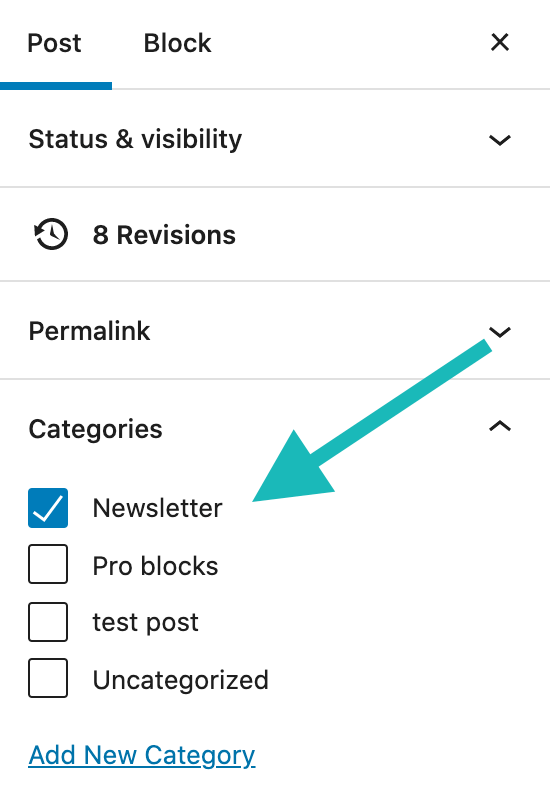
Step 2. Write your post
You can start adding content content to the editor as you’d do to write an article. Since we are using Newsletter Glue Pro, we also get access to newsletter specific custom blocks.
As an example, check out our author byline and post embed pro blocks. How they look on this blog post is exactly how they’ll show up on email as well.
You can also save time creating a newsletter by making use of block patterns. Newsletter Glue ships with some pre-built pattern templates to help you get started quickly. They are easily customizable and are located at Newsletter Glue > Templates & Styles. If you want, you can add additional patterns to the library and they will be available inside the editor.
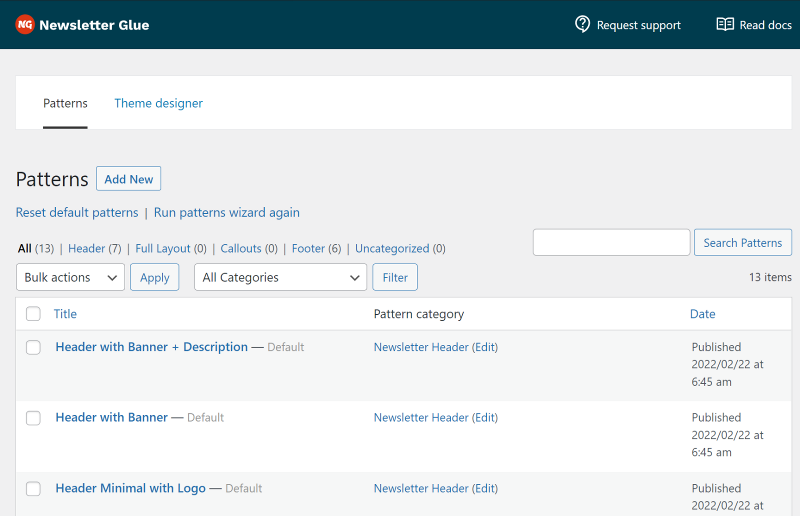
Once you are into the editor, you can insert the patterns by clicking the plus icon “+” in the header, then switching to the Patterns tab, and then clicking the Explore button.
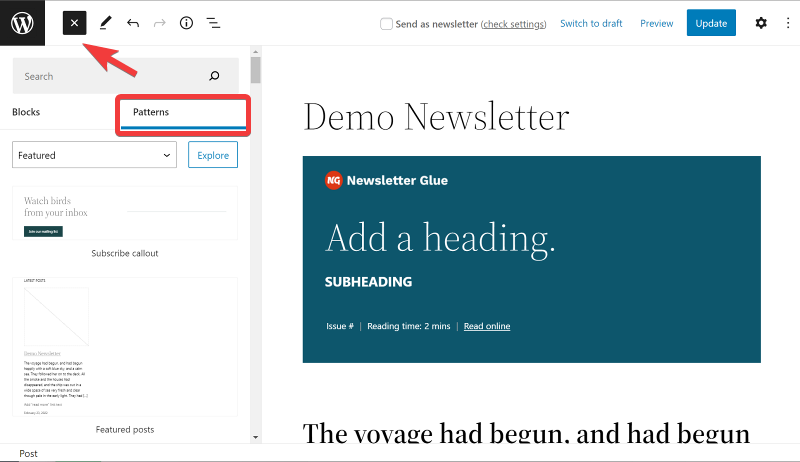
This will open a popup in which you can scroll through the sidebar to find the Newsletter Glue patterns at the bottom.
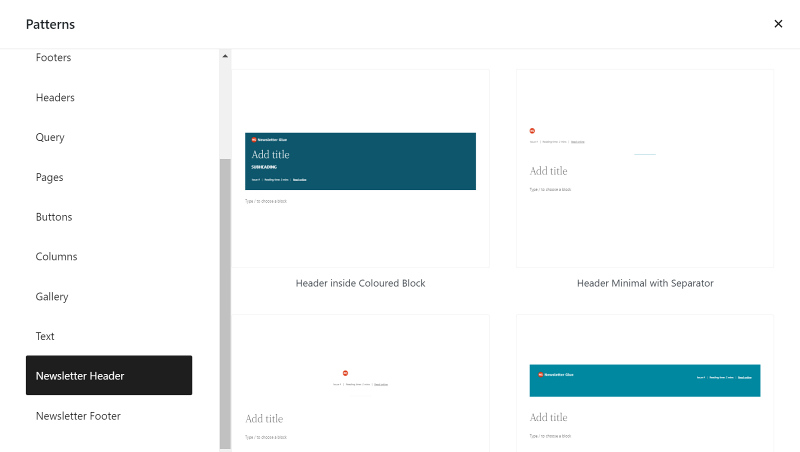
Step 3. Publish
Now that you’ve written your newsletter, it’s time to publish.

You already know how this works from the section above.
- Add in the relevant details and double check your settings.
- Send yourself a test email or check out the preview email in a new tab.
- And when you’re ready… Publish!
If you’d like to schedule your newsletters well in advance, you can do that too. Simply change your article publish schedule from immediately to a specific date and time in the future.

Weirdly enough, that’s it. 🙂
Because you spent time setting everything up for yourself, your actual publishing workflow has become really simple.
I hope you enjoyed this tutorial. It was a monster one!
If you were able to follow this guide to create your own paid newsletter, please leave a link to your newsletter in the comments below, I’d love to check it out!
And of course, if I’ve missed out on something, please leave a comment and let me know too.
Best of luck with your newsletter empire! I’m rooting for you!

